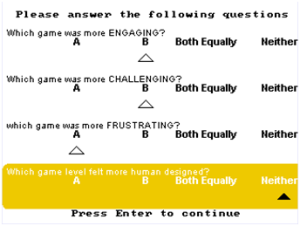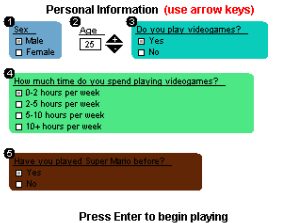Data collection protocol
58 volunteers participated in the recording sessions (28 male, with player age ranging from 22 to 48 years), which took place in Denmark (with participants of different ethnic backgrounds) and Greece (with mostly Greek participants). Participants played a total of 321 games (more than 6 hours of recording in total).
The dataset contains demographic information about participants’ gender, age, frequency of playing games, hours spent on gameplay on a weekly basis and any previous experience with Super Mario Bros.
Players played level A and had three chances to finish it after which they were presented with a rating questionnaire which asked them to report their level of engagement, frustration and challenge in a scale between 0 to 4 (0 denoting “not at all’’, 4 meaning “extremely’’). The process was then repeated with a different game level (level B) and another rating questionnaire.
After completing these two games, players were asked to report which of the two games they preferred via a 4-alternative forced choice (4- AFC) questionnaire protocol: A over B; B over A; both equally engaging/frustrating/challenging; both equally not preferred.
Finally, players were given the option to play more pairs of games (most of them did) or quit the game.
General Data Description
In the PED dataset, video files are sorted in different folders, based on a player identification tag (e.g. “ama 16 03”). These folders contain video files, each of them corresponding to a game level played by the specific player (e.g. “1 A”, “1 B” for the first set of games, “2 A”, “2 B” if they played a second set, etc.), and associated with a CSV file containing the ID code of time-stamped game events. Table I shows the logged events and their ID codes.
Game Context (Content) Data
- Number of gaps and average gap width
- Number of enemies
- Placement of enemies
- Number of powerups
- Number of boxes
Gameplay Behaviour Data
- Level completion
- Mario death and the cause of death
- Picking up blocks and bonuses
- Killing enemies
- Changing mode and time spent in small, big or fire mode
- Changing direction and time spent moving left, right, jumping, ducking and running
- Full trajectory of Mario as a combination of events.

Visual Behaviour Data
We collected the Video Stream (AVI) for all sessions. We used a camera capable of recording high definition footage and good quality video in different lighting conditions, so as to minimize gain-related noise in the video signal when filming in environments with moderate lighting (Canon Legria S11). Each AVI video has been processed providing visual features and eliminating the need for further processing to detect facial features. Detected features from each video are contained in a text file which contains the following tab-separated data:
- Timestamp (time from the beginning of the level)
- Two 2-D vectors describing the player’s eye gaze and head pose horizontally and vertically
- A float value corresponding to whether the player stands still, approaches the screen or moves back
- Head roll in degrees
- A list of 17 prominent prominent facial features around the player’s eyes (top, bottom, left, right corners), mouth (top, bottom, left, right corners), nose (nose tip), and eye brows (left corner, mid point, right corner).
Demographics and Self-Annotations of Experience
Each player folder includes a CSV file containing player demographics (see questions in the figure below) and the player responses to the questionnaire about prior experience and another CSV file containing self-reported rating values for each level and self-reported preferences between the two levels of the same set. Possible rating values correspond to “Extremely”, “Fairly”, “Moderately”, “Slightly” and “Not at all”, while the preference value (see figure below) denotes which of the two levels was more engaging, challenging and frustrating. As noted earlier, players can choose between levels A and B or, alternatively, report no clear preference (levels are “Equally” ranked or “Neither” level is ranked).

The Player Experience Questionnaire (preference) used in our experiments.

The Player Experience Questionnaire (preference) used in our experiments.